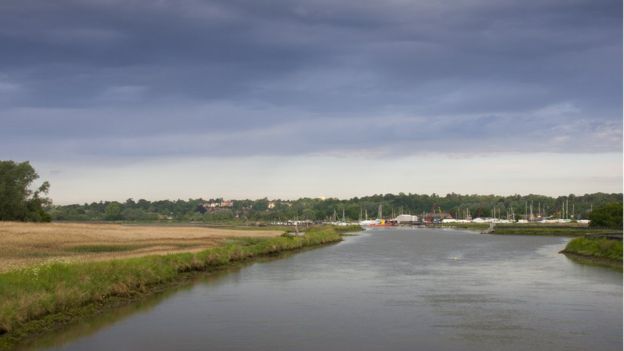
PHOTO: bbc.com
RENDLESHAM, ENGLAND – Archaeologists have stumbled across a massively important find near one of the UK’s most historically significant archaeological sites.
During the 8th Century, the historian Bede compiled his Ecclesiastical History of the English Nation. In the book, in chapter twenty-eight, he mentions what he calls a “king’s village” near Rendlesham. There, it’s said that the ordained bishops of the West Saxons consecrated Wilfrid as the King of Gaul. Until now, there has been no archaeological evidence of any such “king’s village”, but new archaeology in Rendlesham is proving Bede right.
A group of archaeologists and historians were researching an area at Rendlesham, just four miles away from the famous Sutton Hoo burial site. It was there, this year, that they found something immensely exciting: the remains of a 75ft by 30ft structure that they believe was once a royal hall or palace.
Ms. Faye Minter, of Suffolk County Council’s archaeological unit, believes this is the palace referred to by Bede as the “king’s village”.
The find was discovered using aerial photography and geophysical surveys. Since its discovery, archaeologists have been hard at work uncovering the vast treasures the ancient building once held.
So far, they’ve found about 4,000 items, including coins and weights and the intricate metalworking the Anglo-Saxons were so known for. 1,000 of the items definitely check out as belonging to the Anglo-Saxon culture.
![An example of classic Anglo-Saxon metalworking: a gold buckle recovered from the famous Sutton-Hoo burial site. [PHOTO: wikimedia]](https://historythings.com/wp-content/uploads/2016/09/Great_Buckle-1024x479.jpg)
An example of classic Anglo-Saxon metalworking: a gold buckle recovered from the famous Sutton Hoo burial site. [PHOTO: wikimedia]
The Anglo-Saxons began to inhabit Great Britain during the 5th century AD. They migrated from the European mainland, descending from Germanic tribes who intermarried with native Celtic peoples living in the British Isles.
Halls like the one found at Rendlesham would not have been uncommon. Most buildings built by the Anglo-Saxons in Britain were quite simple. They built towns at agricultural centers, and a main hall, like the one uncovered at Rendlesham, would be the cultural center of the settlement.
About the site at Rendlesham Dr. Helen Geake of the British Museum said, “There would have been quite a few of these palaces or halls dotted around. The king [of the time] would have toured his kingdom in order to show his magnificence to his people, so he would have had lots of places to base himself around East Anglia.”
She believes that the palace found at Rendlesham is only one of several such structures archaeologists have yet to find.
![The Sutton Hoo Burial Site [PHOTO: csis.pace.edu]](https://historythings.com/wp-content/uploads/2016/09/sutton_h-300x214.gif)
The Sutton Hoo Burial Site [PHOTO: csis.pace.edu]
Beneath one of the largest, Brown and his team of archaeologists found a wealth of history – a site that’s comparable in importance to King Tutankhamen’s famous tomb in the Valley of the Kings in Egypt. Buried there was the imprint of an Anglo-Saxon ship measuring 88 feet long. At it’s center? A burial chamber filled with thousands of treasures and holding the body of an ancient British king.
The theory is now that Rendlesham and Sutton Hoo are closely related. Some historians and archaeologists believe that Sutton Hoo is, in fact, the resting place of the self-same king who built the “king’s village” at Rendlesham.
Do we know for sure? No. It’s just speculation at this point, but it’s a pretty good guess. British kings were often buried near their homes.
Perhaps Sutton Hoo and now the King’s Village at Rendlesham are just the beginning. Archaeologists will continue to research the surrounding area in hopes of finding more historical treasure.
“We hope there will be more to come. Whether or not they would be ship burials like Sutton Hoo, who can say?” – Faye Minter, project coordinator.

